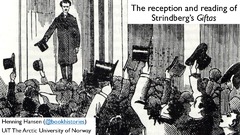The Reception and Reading of Strindberg’s Giftas (1884–86)
Permanent lenke
https://hdl.handle.net/10037/30891Dato
2019Type
Conference objectKonferansebidrag
Forfatter
Hansen, Poul Henning GustafSammendrag
Giftas (Getting married; 1884–86) has been marked by its scandalous reception among contemporary society. The semi-autobiographical collection of short stories depicting married life shook society and has cemented the perception of Strindberg as a misogynist author. Even if Strindberg and his publisher Albert Bonnier had expected certain turmoil, they could hardly have anticipated that they would be at centre of attention in one of the great media events of the late nineteenth century in Sweden.
The condescending characterizations of women and of the holy communion struck fierce debate, and many called for legal measures. Within days after the book became available in the bookshops, the book faced charges of blasphemy and the remainder of the copies were seized by the authorities. The extensive media coverage concerning the book provoked a rush to the bookshops throughout the country, and before the orders were executed over 90 percent of the copies had been sold.
In this paper I will use two different kinds of sources to trace the reception of the book. Firstly, I will use the trove of digitized newspapers Swedish newspapers to trace the reporting in the contemporary press, and secondly, I will use preserved sales’ records from one of Sweden’s largest bookshops at the time, which can identify of some of the people buying Strindberg’s infamous book.
Strindberg was eventually acquitted of the charges, but the prosecution arguably dealt a severe blow to his future authorship and to the movement of young Swedish writers as a whole. This paper offers a piece of the puzzle to the story of Giftas in particular and of the Scandinavian book market in general during the late nineteenth century.
Metadata
Vis full innførselSamlinger
Copyright 2019 The Author(s)


 English
English norsk
norsk